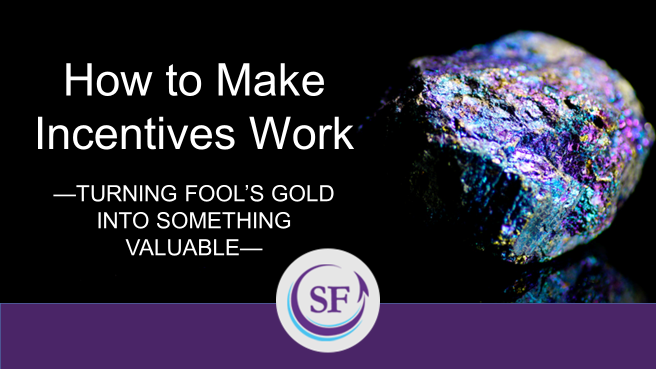The VP of sales whispered to me, “I’m about to be embarrassed.” I looked at him quizzically. He continued, “I’m about to announce the incentive plans for selling our new product. I didn’t realize you’d be here. I know how you feel about incentives.”
I nodded in agreement. I am an outspoken, and published, advocate for the body of evidence proving how detrimental external rewards are on performance. Whispering back, I asked, “Why are you offering incentives?” I could read the consternation as he searched for an answer. “I don’t know. It’s what we always do when we release a new product.” My one-word follow-up question deepened the burrows on his forehead, “Why?”
After that meeting, the VP and I had a fruitful discussion about the role of incentives. I hope you might benefit from these ideas—especially if you are about to incentivize someone’s behavior, or you are the one being incentivized!
Ask why incentives are needed
Engineers ask “Why?” at least five times to find the root source of a mechanical or electrical issue. Ask “Why?” to understand the underlying reason for relying on incentives to motivate behavior. For example, before offering a $2000 bonus to sales reps with the highest sales on a new product…
- Ask: Why are we offering this incentive?
- Answer: To increase sales.
- Ask: Why assume sales reps won’t sell the product without an incentive? Is the product flawed? Do your customers not really need it?
- Answer: No, the product is good and our customers want it. But, our sales reps get in the habit of selling what they have, not the new stuff, so we need to incentivize them to sell something new. (If the answer is, Yes, the product is flawed and our customers don’t want it, then there’s a good chance the incentives are a disguise for bribing people into immoral and unethical behavior.)
- Ask: Why would sales reps not take advantage of a new product? Have they had enough exposure to the product to advocate for it? Are they lazy? Are they bored? Are they content and not needing to generate more sales? Are they so conditioned with incentives that they don’t care about customer needs? Are they not aware of the benefits the new product offers clients?
- Answer: We haven’t done a good enough job of providing the rationale for the product, the problems it solves for our clients, or the opportunities this product presents for building meaningful relationships.
The “why” in this case led to a deficiency in the way the product was introduced to the sales team and an alternative solution to incentivized selling.
Frame incentives differently
When compared to sales teams with higher-quality motivation to sell, sales teams motivated by contingent rewards consistently underperform. If you are still afraid to eliminate incentives, or don’t control the use of them, you need to learn to reframe them. You need to frame incentives so reps are less likely to internalize them as their reason for selling.
Frame incentives as the organization’s way to shine a light on how important the product is. For example, provide rationale for why the product was developed in response to customer requests and needs. Describe why the product is essential to your organization’s success and helps satisfy its values and purpose. Explain that incentives are merely the company’s way of highlighting the importance of the new product—not to be confused with the reason to sell it. Allow sales reps to find their own values-based reason for selling the product from the information you provide.
Conduct meaningful conversations
Use incentives as a good excuse to have a meaningful conversation with your reps to assess their motivation for selling the product. Ask how they feel about the incentive. You might be surprised. This particular VP of sales was shocked to discover that many reps are insulted by incentives. Good reps often pride themselves in selling the right thing to the right customer — not for a reward, but to demonstrate their expertise, skill, and service approach to their work. Acknowledge their high-quality motivation and make that their focus, not the incentive.
One rep admitted that incentives created a ton of pressure. She explained that $2,000 was enticing to her as a single mother with limited resources. She felt she should strive to win the bonus; experiencing guilt if she didn’t go for it. But, those feelings gave away to more guilt as she found herself “pushing” the product for the wrong reasons and risking her clients’ trust. Her excitement at having a new product in her quiver of client solutions was replaced with pressure, which affected her overall performance.
Incentives are like fool’s gold — shiny objects that take away a sales rep’s focus from more meaningful reasons for selling the product. They also take away a sales leader’s focus from the true role of a leader. Defaulting to incentives is a lazy way to lead. Paying people off may seem a simple and fast way to generate sales, but you pay the price in lost energy, creativity, and sustainable performance.
But if you leverage incentives to generate deeper thinking about the value of your products and services, to highlight your organization’s purpose, and to have meaningful motivation conversations, the fool’s gold might be transformed into something truly valuable.
Susan Fowler implores leaders to stop trying to motivate people. In her latest bestselling book, she explains “Why Motivating People Doesn’t Work … And What Does: The New Science of Leading, Engaging, and Energizing. She is the author of by-lined articles, peer-reviewed research, and six books, including the bestselling “Self Leadership” and the “One Minute Manager” with Ken Blanchard. Tens of thousands of people worldwide have learned from her ideas through training programs, such as the Situational Self Leadership and Optimal Motivation product lines. For more information, visit SusanFowler.com.
If you enjoyed this article, join SmartBrief’s e-mail list for our daily newsletter on being a better, smarter leader.
